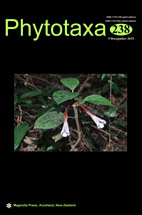Abstract
We here describe, illustrate and compare with related species Calyptranthes corticosa, Myrcia breviflora, M. cantana, M. castanea, M. divisoria, M. integra, M. laxa, M. longiramea, M. manausensis, M. maraana, M. symmetrica, M. uaioai and Plinia humaitana. Calyptranthes corticosa, from the Brazilian state of Acre, is related to C. paniculata, but is distinguished by its strongly angulate twigs and pauciflorous inflorescences; Myrcia breviflora, from the Brazilian state of Amazonas, is related to M. tafelbergica, but has shorter inflorescences with pentamerous flowers; M. cantana, from the Brazilian state of Roraima, is close to M. saxatilis, but has narrower blades and tetramerous flowers; M. castanea, from Amazonas, is related to M. magnoliifolia, but has persistently pilose, bullate leaves and densely pilose inflorescences and flowers; M. divisoria, from Acre, is related to M. calycampa, but has pilose twigs, larger blades and longer inflorescences with persisting bracts; M. integra, from the Brazilian states of Amazonas and Roraima and the Peruvian department of Loreto, is related to Marlierea umbraticola, but is distinguished by the blades with adaxially raised midvein and tetramerous flowers; M. laxa, from Amazonas, is related to M. aequatoriensis, but has smaller petioles, blades not bullate and pilose flowers; M. longiramea, from Amazonas, is related to M. clusiifolia, but has narrower blades crowded at the top of long branches and tetramerous flowers; M. manausensis, from Amazonas, is related to M. splendens but has blades with larger glandular dots and flowers with ovary longitudinally ridged; M. maraana, from Amazonas, is related to M. obumbrans, but has narrower, discolorous blades and tetramerous flowers; M. symmetrica, from the states of Amazonas and Pará, is close to M. plusiantha, but differs by its mostly acuminate blades, shorter inflorescences and tetramerous flowers; M. uaioai, from Roraima, is related to Myrcia gentryi, being distinguished through its elliptic blades with adaxially raised midvein and consistently solitary flowers, and Plinia humaitana, from Amazonas, is related to P. pinnata, but has shorter, wider blades and seed without hypocotyl. Additionally, conservation status is proposed for all species; nevertheless, considering the fact that several species are known only from one collection a/or by mostly ancient collections, their status attribution is necessarily tentative.

